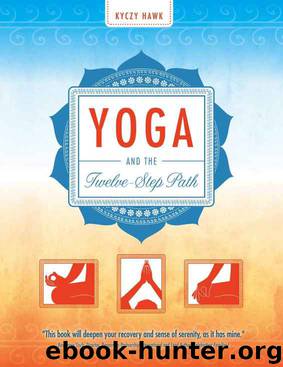Yoga and the Twelve-Step Path by Kyczy Hawk

Author:Kyczy Hawk [Hawk, Kyczy]
Language: eng
Format: epub
Tags: Health, connect more fully, mind and spirit, new experience of recovery, body, twelve-step, recovery, sympathetic guide, physical and spiritual health, threefold aspects of addiction, integrative practice, Yoga
ISBN: 9781936290888
Google: v4QwBwAAQBAJ
Amazon: 1936290804
Goodreads: 14651388
Publisher: Central Recovery Press
Published: 2012-04-16T04:00:00+00:00
EXERCISE
1. A resource for my self-study is ____________.
2. A mentor in my journey of self-study is ____________.
3. I can rely on ____________ to help me in my journey.
Ishvara Pranidhana: Surrender. The sutras of Patanjali refer to “reverence to a higher intelligence or the acceptance of our limitations in relation to God, the all-knowing” (2.32).
Many of us have experienced the process and need to surrender over and over; sometimes it is the same issue, sometimes the same subject in a different form. A tool in being able to “turn it over” is to revitalize and align ourselves with our faith, bringing awareness over and over again to the issue, letting go. Our ego, our will, may reassert itself time and time again. This tenacity of the ego to be in charge is the challenge that we face when practicing ishvara pranidhana. The more we are able to let go, the closer we are to our divine self and our Higher Power.
Letting go of the results of your work, taking the ego out of them, is part of developing trust and faith in your Higher Power. This is also ishvara pranidhana. Clinging to the outcome of our actions forfeits surrender. To give up the outcomes to your Higher Power increases surrender; one can see that both karma and kriya yogas are embraced in this observance, integrating tenets from other practices. This does not mean to not do your best. Doing what is right with right effort, and then letting go of the outcome or the results, is the very nature of surrender.
This concept and practice comes at the culmination of all the other yamas and niyamas. It prepares one for the rest of the royal path and for the beauty of the discoveries to come. Be mindful of the ego-self, as it will reassert itself with regularity. Our path is progress, not perfection. It is a practice, and it is the steadfast practice of this niyama with the others and the yamas before them that will result in a beautiful unveiling of the true self.
Do only that which is before you to do; do not intrude on the work of others. Deborah Adele writes, “As we let go of what we cannot change, we are able to grow more and more into our unique gift and contribution to life. . . . It is an image of strength and softness at the same time . . . to be strong enough to engage each moment with integrity and at the same time to live soft enough to flow with the current of life.”5
Surrender can be one of the most confusing concepts in the rooms of recovery. We are fighting for our lives in abstaining from our addictive substance or behavior, for it was going to kill us. Then we hear the slogan, “surrender to win.” What a paradox!
A lot of preparation has taken place to get here, to this moment in our lives. Working the Twelve Steps of recovery with a sponsor
Download
This site does not store any files on its server. We only index and link to content provided by other sites. Please contact the content providers to delete copyright contents if any and email us, we'll remove relevant links or contents immediately.
Bodyweight Strength Training by Jay Cardiello(7179)
Tools of Titans by Timothy Ferriss(6934)
Born to Run: by Christopher McDougall(6248)
Inner Engineering: A Yogi's Guide to Joy by Sadhguru(5886)
Asking the Right Questions: A Guide to Critical Thinking by M. Neil Browne & Stuart M. Keeley(4563)
The Fat Loss Plan by Joe Wicks(4231)
Bodyweight Strength Training Anatomy by Bret Contreras(4053)
Yoga Anatomy by Kaminoff Leslie(3696)
Science and Development of Muscle Hypertrophy by Brad Schoenfeld(3573)
Dynamic Alignment Through Imagery by Eric Franklin(3481)
The Four-Pack Revolution by Chael Sonnen & Ryan Parsons(3480)
ACSM's Complete Guide to Fitness & Health by ACSM(3459)
Yoga Anatomy by Leslie Kaminoff & Amy Matthews(3392)
Bodyweight Strength Training: 12 Weeks to Build Muscle and Burn Fat by Jay Cardiello(3346)
The Ultimate Bodybuilding Cookbook by Kendall Lou Schmidt(3308)
Exercise Technique Manual for Resistance Training by National Strength & Conditioning Association(3285)
Nutrition for Sport, Exercise, and Health by Spano Marie & Kruskall Laura & Thomas D. Travis(3232)
Nutrition for Sport, Exercise, and Health by Marie Spano & Laura Kruskall & D. Travis Thomas(3228)
Yoga Therapy by Mark Stephens(3217)
